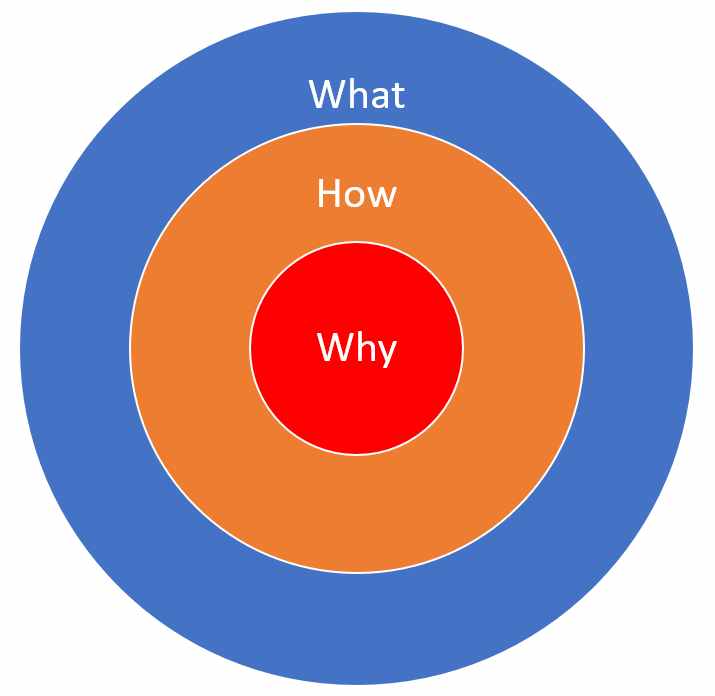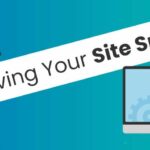Have you ever heard of the Golden Circle? Most great organizations and leaders understand the basic concept of the golden circle but Simon Sinek turned it into a simple graphic that allowed many more people to understand the power of recognizing your “Why”. Your “Why” expresses your internal motivation for doing what you do and is the reason most consumers, employees, and investors relate to a brand.

Most businesses when talking to customers or employees start with “What” they sell followed by “How” they are different or how they do what they do. They focus too much on the features and benefits of their offering. If they are lucky, they may include a reference to their “Why” buried deep down in their “About Us” page but most businesses fail to ever articulate their “Why” and sadly most employees don’t even know the “Why” on which the business was founded.
What is your “Why”
Your “Why” is what gets you out of bed every morning and injects passion and fulfillment into your life. Whys are nested. A business has a “Why” and individuals have their own “Whys”. When they align, it generates a passion that creates an emotional bond between the business and its customers, employees, and even investors. As a business owner, having a clear “Why” is like wearing a pair of corrective lenses because abstract thoughts become clear and easier to articulate.
Your “Why” starts with understanding the significant event that had the most profound impact on your life. Your “Why” creates your purpose and gives you the emotional energy to face tough challenges and creates a gravity drawing others into your orbit around your “Why”.
Consider the brand Patagonia. The founder, Yvon Chouinard, was an outdoor enthusiast all his life and was a member of the Sierra Club even in his youth. His “Why” moment came when he attended a Ventura City Council meeting in early 1970. The topic of the meeting was to erect barriers along the Ventura river to prevent erosion. Experts touted the benefits of channelizing the river. It looked like a done deal until a 19-year-old student shared images of the animals that lived along the stream bed that would suffer from the river’s channeling. The student’s presentation brought the house down. It was at that moment that Yvon realized that one guy could make a difference. At that very moment, he became an environmental activist. From that moment on, he used the “Why” of a committed environmentalist as a lens to define the directions of the Patagonia brand. Yvon’s “Why” allowed him to attract committed employees, customers, and investors that were as passionate about environmental issues as he was.
If you want customers, employees, and investors to care about your brand, you need to start with your “Why”. When they understand what happened in your past that created your “Why” and they see how motivated you were by your “Why” that you took the risk to start a business, they will be far more likely to embrace your beliefs and open to hearing your “How” and “What”.
The reason your “Why” is so powerful
The reason that starting with your “Why” is so powerful according to Simon is the fact that it follows the biology of the brain. Perhaps you have heard the axiom that “People make decisions based upon emotions and justify those decisions with logic.” The basis of this axiom is that:
“What you feel is more important than what you think.”
When you share the dreams, beliefs, and emotions that drove you to take the risk to start a business, you are sharing your “Why”. When you lead off with your “Why”, you are directly addressing the limbic region of the brain that is responsible for making decisions. Once a person relates to your “Why”, the “How” and the “What” become the logic they use to support their decision to buy, work for you, or invest in your business.
However, perhaps because we, as consumers see it over and over again, most businesses share “What” they do upfront. They are inclined to follow the crowd and launch into describing the features and benefits of their offering or business which addresses the logical part of the brain before they connect with the person’s emotional and decision-making part of the brain by leading off with their “Why”. Just because lots of businesses start with their “What’ does not make it right.
Let’s face it, customers and workers are not inspired by what you do or even how you do it. Your “What” and your “How” are emotionless. As a result, most people will never be emotionally connected to your brand. They will only look at objective criteria such as cost, how much they will get paid, or the return on investment when they fail to connect emotionally with your brand. Customers that fail to recognize your “Why” will never be loyal or care about your brand. And employees that do not recognize and embrace your “Why” will never do whatever it takes to make the business a success.
How your “Why” attracts
Influential leaders like Mahatma Gandhi, Martin Luther King, and Nelson Mandela are known for their “I have a dream” speech and amassed a considerable number of followers. Their key to a successful movement was that they shared the experience that led to their “Why”. Their story of past oppressions tapped into their followers’ emotions. Later, when they shared their vision of the future, their followers were already primed and emotionally connected. Imagine if instead of connecting with their followers with their “Why”, they began with their “What” and “How” and delivered a “I have a plan” speech. It is very unlikely they could have sparked a movement that went on to change the world.
One of my long-term clients, Gregg Sheldon was not a very good student in high school. He shared with me that when growing up he struggled with tasks that required memorization. As a result, he performed poorly on tests Because of his poor test scores his teachers said that he would not amount to much as an adult. But somehow, he knew that his calling was working with kids, so he grudgingly went to college to become a social worker. As he began working with troubled teens, he connected with many of them who suffered self-esteem issues because they too were told they would never amount to much. It was then that Gregg was struck with his “Why”. He knew that to make a difference in these kids’ lives, he had to connect emotionally with them and in a way that they could also relate to him and hear his message.
He recognized that the same traditional academic institutions that failed him were failing his clients. He remembered that what contributed to his self-esteem was working with his hands, and he was good at it. Gregg quit his job as a social worker and went on to earn his ASE certification. Initially, he thought his career would take him on the path to becoming a high school shop teacher so he could connect with kids that were left behind by traditional school systems.
After working as an automotive mechanic to hone his craft, he reexamined his “Why” and knew that being part of the same type of institutions that failed him and his former clients by becoming a school teacher may not produce the results that he wanted to achieve. Using his “Why” as a lens to steer him down the path that would help him achieve his goal, he pivoted and started Autoshop Vocational PBC to teach young adults to work with their hands and restore their confidence.
To help fund his school while he was building up a clientele, Gregg had to resort to creating Used Car Part Art and teaching Pitstop Workshops to women and new drivers to keep a roof over his head and food in his belly. While Gregg took advantage of every opportunity to share his “Why”, he created a kind of gravity that pulled others into his orbit.
Gregg is a great example of how the power of your “Why” can not only fuel and channel your own emotional energy but create social agents and attract like-minded people willing to help you achieve your goal. In fact, it was his “Why” that pulled me into his orbit as a business mentor and friend to help him succeed.
While Gregg is still on his journey to help place troubled youths on a path to a successful life and career, with Autoshop Vocational, his powerful “Why” has provided him with the emotional energy to not only overcome all the obstacle in his path but also to build an army of supporters willing to share his message far and wide.
Conclusion
Your “Why” is a story from your past that caused you to take action. When a stakeholder, be it an employee, investor, or customer, can emotionally relate to your “Why”, you will capture their heart and their wallet and commitment to do what it takes to succeed will follow.
What is your “Why”?












